Overview
Research in the Velonia Group lies in the interface of chemistry, biomaterials and bionanotechnology. Our research involves synthesis and applications of biopolymers or sustainable polymers aimed to serve as biomaterials and address the needs of diverse applications. Special focus is given to protein-polymer conjugates, i.e. hybrid block copolymers synthesized to mimic natural superstructures. We study the molecular properties and assembling architectures observed in a variety of synthetic biopolymers together with their applications in diverse areas.
Protein-Polymer Conjugates
We focus on elucidating bioconjugation and providing easily accessible synthetic approaches.
Giant Amphiphiles
Design, synthesis and characterization of self-assembling bioblock-copolymers.
Synthetic Biopolymers
Synthesis of biopolymers with a focus on sustainable means or multifunctionality.
Applications
Drug delivery, nanoreactors and catalysis.
Concepts
The lines of our research and details of selected recent publications are given below.

Protein-polymer biohybrids
Modifying biomolecules with polymers provides us the means to integrate protein functionality with polymer material properties. Our focus is to simplify available synthetic means and improve the accessibility to tailored made protein-polymer functional conjugates. The most recent synthetic protocols involve:
Grafting to approaches via click bioconjugation reactions of proteins with presynthesized end-functionalized polymers,
Grafting from stategies employing reversible-deactivation radical polymerization (RDRP) approaches.
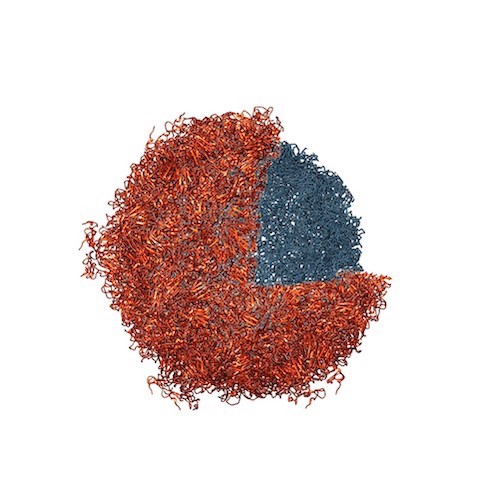
Giant Amphiphiles
Amphiphilic protein-polymer conjugates - Giant Amphiphiles - are designed to integrate protein functionality with polymer material properties and self-assembly.
Aiming to optimize their synthesis we developed a variety of approaches leading to amphiphilic biomacromolecules with high structure definition and studied the resulting supramolecular assemblies. We further introduced multifunctionality on the polymer moiety and demonstrated the ability to in situ form nanoreactors i.e. functional proteinosomes.
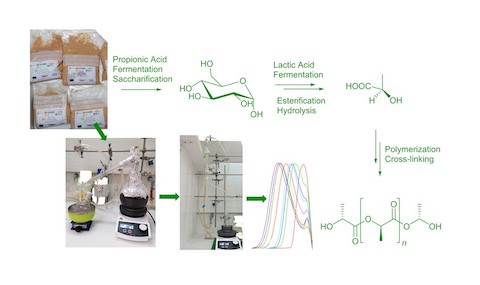
Sustainable and Functional Polymers
We are involved in polymer and biopolymer synthesis aimed to provide sustainable solutions and/or assemblies with diverse biotechnological applications.Our efforts involve:
Synthesis of polymers forming nanoparticles aimed at biomedical applications,
Synthesis of biodegradable polymers with special focus on PLA and PCL,
Production of PLA from food waste.
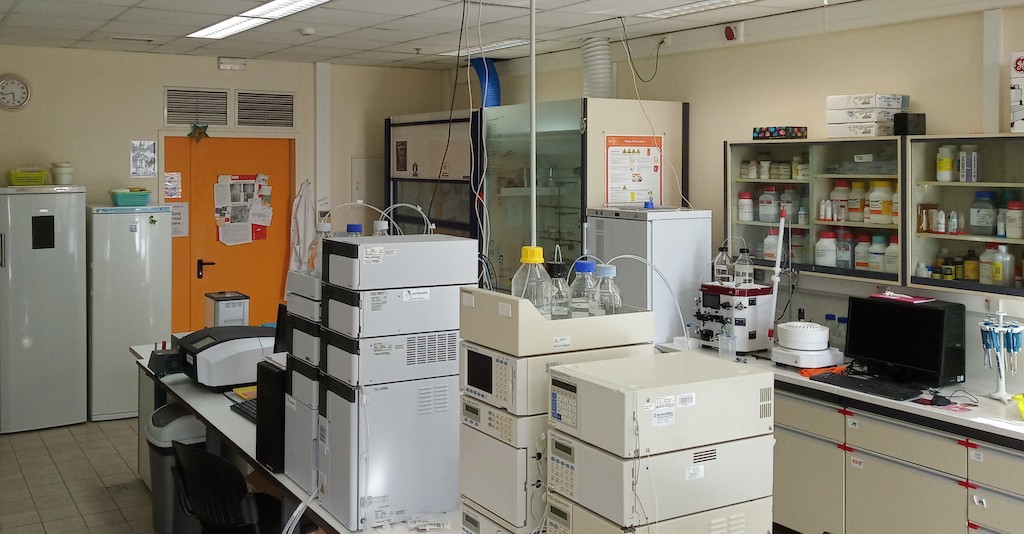
Applications
We are involved in studies focusing on biopolymer applications.
We study solution behavior of polymers and biopolymers expressing assembling and/or "smart"/responsive behavior in aqueous media. We are interested in the properties of compartmentalized nanostructures (micelles, vesicles, or gels) and their application in controlled drug delivery, tissue engineering and catalysis (our true love!).
Selected publications
Selected recent publications are presented below.

Oxygen tolerant photoinduced controlled radical polymerization approach
We recently reported an oxygen tolerant, photoinduced CRP approach which bypasses problems associated with conventional “grafting from” synthetic protocols that are time-consuming and often involve harsh and disruptive deoxygenation methods. This oxygen tolerant, new grafting from approach:
Affords quantitative yields of protein-polymer conjugates within 2 h, avoiding damage to the secondary structure of the protein,
Is compatible with multiple proteins and monomer classes,
Can be performed the absence of additives or external deoxygenation procedures using low-organic content media and ppm levels of copper in buffer, nanopure, tap or even sea water,
Can be implemented under UV, blue light or even sunlight irradiation,
Leads to catalytically active proteinosomes.
All details in: Theodorou et al., Protein-polymer bioconjugates via a versatile oxygen tolerant photoinduced controlled radical polymerization approach
Our efforts now focus on creating new families of complex proteinosomes with diverse applications.
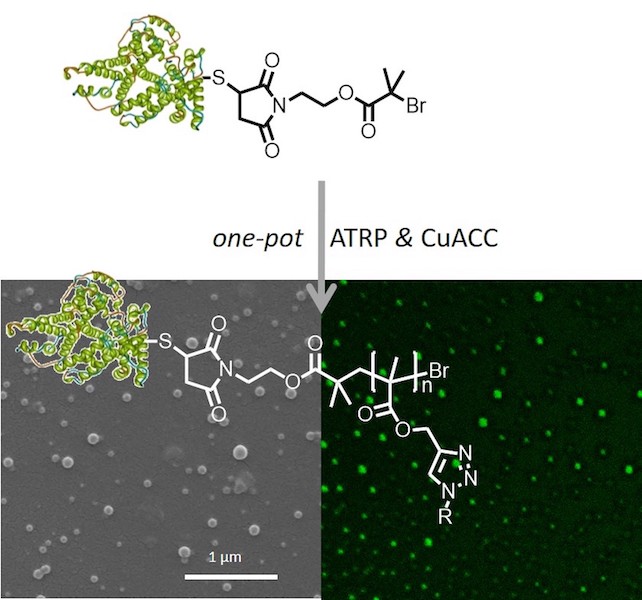
Multifunctional Giant Amphiphiles
A novel class of chemically addressable, multifunctional Giant Amphiphiles was synthesized in excellent yields and polydispersity following simultaneous or sequential living radical polymerization and the click, copper(I)-catalysed azide–alkyne cycloaddition (CuAAC). This new approach allows chemical tailoring of the biomacromolecules and in situ formation of nanocontainers. This approach:
Allows tandem ATRP and click functionalization of proteins,
Allows sequential ATRP followed by post-functionalization of the produced monomers,
Can be used to introduce a variety of functionalities on the polymer moiety,
Allows in situ nanocarrier formation.
All details in: Daskalaki et al., Multifunctional Giant Amphiphiles via simultaneous copper(I)-catalyzed azide-alkyne cycloaddition and living radical polymerization
We aim to fully exploit the post-functionalization approach to create multifunctional nanoreactors.
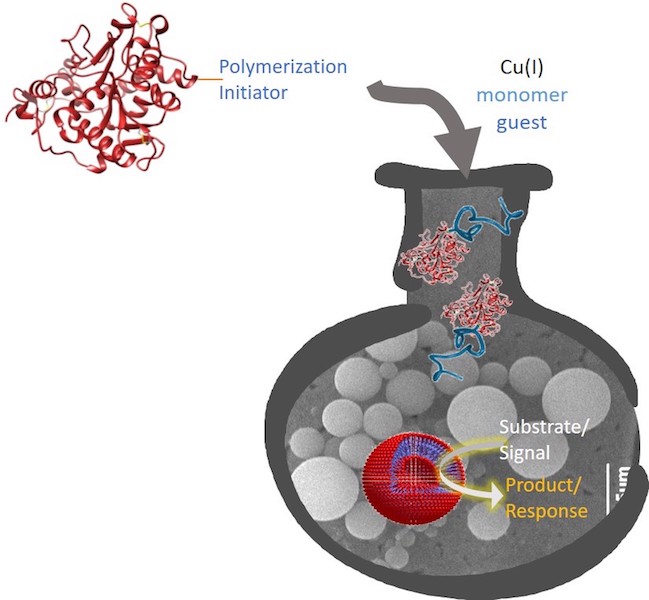
A quantitative approach to Giant Amphiphiles
Amphiphilic bioconjugates were synthesized in situ by grafting polystyrene from a protein using an ATRP approach. The resulting Giant Amphiphiles displayed:
Low polydispersities,
Characteristic self-assembling behaviour,
Ability to incorporate guest molecules,
Membrane permeability.
These giant amphiphile nanocontainers were studied as supramolecular nanoreactors.
All details in: Le Droumaguet et al., In situ ATRP-Mediated hierarchical formation of giant amphiphile bionanoreactors
The team
spends most of the day with ...
and ... chromatography, under conditions